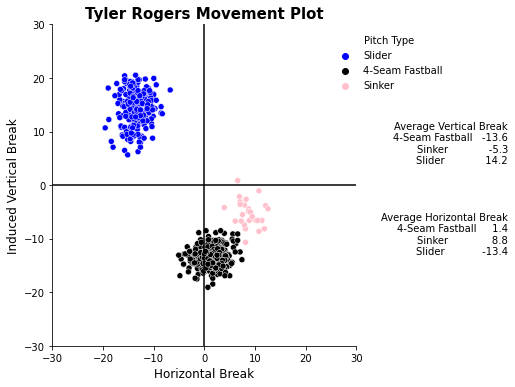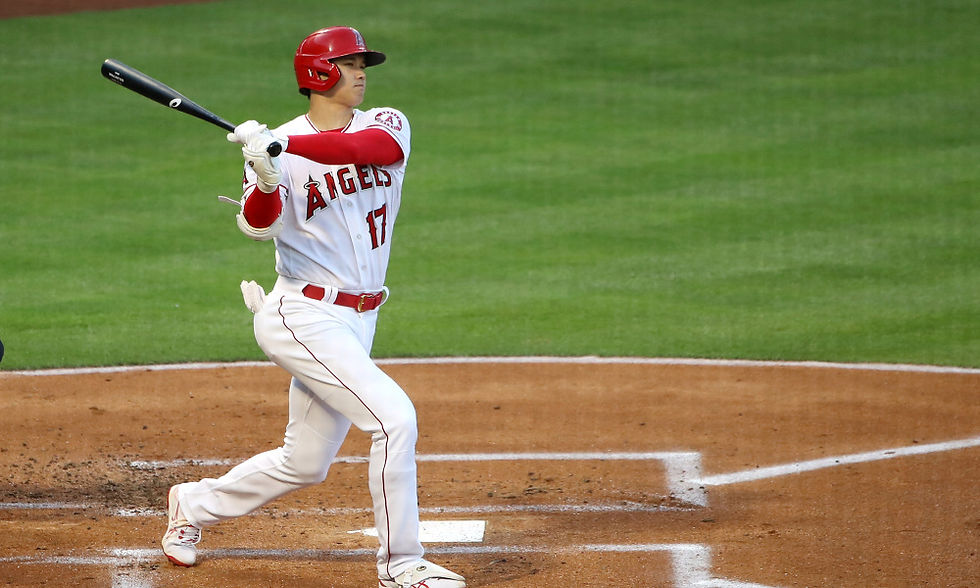The Rundown of Movement Plots
- hudsonhalling5
- Jul 27, 2021
- 7 min read
Updated: Jan 22, 2022
As I have gained experience working in the baseball development industry, I have noticed that many people, even scouts and baseball professionals do not know how to read and interpret movement plots. Having worked with them pretty much every day, I have gained a lot of familiarity with this tool and have begun to further understand pitch design because of it. With that being said, I wanted to write a blog that wasn't as research intensive, but more informative so people can make more accurate assessment of pitch design and pitch quality.
Let's start by breaking down movement of a pitch and then look at some sample charts to understand what they are telling us.
The Basics
To start off with, these plots will always be in the pitchers point of view.

The plot is broken down into 4 quadrants. In the top right, you have pitches with vertical carry (we will talk about this later) and horizontal movement that breaks to the right (into a Right Handed Batter). In the bottom right, you have pitches with vertical drop and horizontal movement that breaks to the right. In the top left, you have pitches with vertical carry and horizontal movement to the left (away from a RHB). In the bottom left, you have pitches with vertical drop and horizontal movement to the left.
Now we all know that it is impossible for a pitch to rise. This plot does not take gravity into account!! Movement plots measure what the spin of a baseball does to its movement. Therefore, gravity is an irrelevant factor that has been taken out by systems like Trackman and Rapsodo in order to tell us what the ball is doing based on the pitchers controllable actions. Balls with backspin will always have a positive vertical break whereas balls with topspin will always have a negative vertical break. Now, we're going to take a look at each pitch and see the ranges those should fall into.
4-Seam Fastball
As we will learn with all pitches, each pitcher can design their pitch in a different way. Some players have high carry fastballs while others have low carry fastballs. A player with a high carry fastball is looking to have a vertical break of 20+ inches. The more carry they have on their fastball, the more the ball appears to rise to hitters. It will also appear to have late life to the pitch, making a 94mph fastball seem more like 97mph. These pitchers tend to give up more fly balls and get more strikeouts. However, they also have the highest home run rates because of the increased number of fly balls that they generate. Some examples of high carry fastball pitchers are Trevor Bauer, Lucas Giolito, John Means, etc. Pitchers with low carry fastballs have a vertical break of 12 inches or lower. These pitchers tend to get a lot of ground ball outs and don't surrender as many homeruns. Their strikeout rates tend to be lower and they give up more singles and low line drives. Pitchers that have a low carry fastball include Tyler Rogers, Tim Hill, and Garrett Richards.
Cutter
Cutters will vary on the vertical carry depending on the pitcher and how they throw their 4-Seam. However, all cutters should have positive vertical carry. All cutters should also have horizontal movement that is away from their throwing hand (top left quadrant for righties, top right quadrant for lefties). The harder you throw your cutter, the tighter the movement is going to be, so players have to find a balance between getting good movement that best suites them while also throwing it at a speed that will fool hitters.
Sinker (2-Seam Fastball)
Sinkers or 2-Seam Fastballs should do the opposite of cutters. They will have less vertical carry than the 4-Seam fastball, but will always have more arm side run to them (top right quadrant for righties, top left quadrant for lefties). Players with elite sinkers can get the ball to have 5 inches of vertical carry, which will feel like an off-speed pitch that can be thrown up to 95 mph. If perfected, this pitch can be an incredible weapon for pitchers to use to get groundouts and wipeout swings and misses.
Curveball
Curveballs should have a negative number for the vertical break and and either a negative number for the horizontal break (RHP) or a positive number for the horizontal break (LHP). The Shape of the curveball impacts how much vertical drop that a pitcher will get. If they want a big sweeping curveball, they should aim for 18+ inches of vertical drop. If they want a tight spinning, faster curveball, they should look to get about 10 inches of vertical drop. Anything less than that becomes more of a slider or an in between pitch that they don't know what to do with.
Slider
Sliders are very similar to the Curveball's movement profiles and many young athletes often get these two pitches confused. The main difference between the two is that Sliders have much more horizontal movement and much less vertical drop. In fact, some players even have a positive vertical carry on their sliders! Athletes run into problems when their Curveball and Slider do the same things. Instead of going for one justified number for each, players and coaches should evaluate the players entire repertoire to decide either which pitch to use, or to decide which pitch to adjust and how to do so.
Splitters and Changeups
Splitters and changeups are essentially the same movement wise so we'll just group them together. These pitches should have a positive vertical carry and a horizontal movement that is similar to the 2-Seam Fastball. Ideally, we are looking for a sizeable difference between this pitch and the fastball so hitters are fooled, not just on speed, but on the movement as well. An elite changeup or splitter will dive down and away to a lefty or down and in to a righty and make them look foolish. Some players can even get a negative vertical carry on this pitch which means it acts like a reverse slider!
What is Gyro Spin?
You might be asking what happens when a pitch is thrown that lands on the (0,0) point. Well, that is called Gyro spin and the only impact on this ball is gravity. This doesn't necessarily mean it won't move side to side or move at all. This just means that the spin-based movement has no effect on the pitch whatsoever.
Examples
Now that we have a basic understanding of movement plots, lets graph a few and see what we find.

The first example I want to look at is Jacob DeGrom. DeGrom is having a historic season and it's easy to see why from his movement plot. He has 3 distinct pitches that all have very unique movements. His fastball plays at an average carry of about 16 inches, which really doesn't matter too much when you throw 102 mph consistently. His slider doesn't sweep as much as other's might, but the pitch matches perfectly for what his fastball brings. His changeup has incredible movement and yet again shows why he's the CY Young front runner by a long shot.

The next example I want to highlight is Max Scherzer. While Max doesn't have the unique movement like DeGrom, he does an incredible job of matching the axis of spin of 4/5 pitches. If you were to draw a line from his fastball to his curveball, you would run through 4 of his pitches. Changeups really aren't supposed to be on that axis anyways because they're a deceptive pitch so his control of his spin is incredible. This allows his pitches to look extremely similar while having noticeably different movement profiles. All of his pitches can play off of each other and this makes his stuff some of the best in the league.

The next example I want to highlight is Trevor Bauer. He does a great job of utilizing both pitch uniqueness and a constant spin axis. His fastball has an average of 20 inches of carry, one of the highest numbers in the league. His changeup also plays phenomenally well off of his fastball as the movement profile is extremely different. He further gets a tremendous amount of break in his knuckle curve and can really throw the hitter off with a pitch that drops as much as his fastball carries. Furthermore, his sinker, cutter, and slider all form a straight line axis that really helps him hide those 3 pitches.

The last incredibly unique example that I want to go over is Tyler Rogers, the submarine pitcher for the Giants. Because he throws submarine. he actually gets topspin on his fastball, which causes it to move like a 12-6 curveball. Everything that he throws is pretty much flipped from what a normal overhand pitcher would look like. His sinker has more carry on it due to the decreased amount of topspin and the seam interaction. His slider actually has positive vertical carry as it is remarkably thrown with backspin. This funky delivery has caused some of his sliders to go viral as they appear to be rising.
While this slider looks like it is rising, it still has an overall downward movement of about two feet. Think of it like a fastball that looks like it's rising but as we discussed earlier, isn't actually rising. The spin and arm slot that Rogers puts on this pitch allows him to create this illusion and an incredibly tough pitch to hit.
Conclusion
Movement plots are an extremely quick and easy way to see what a players pitches are doing and how they can be improved. Unfortunately, they are not widely available so you do have to create your own. With that being said if you would like me to do any players in particular, leave a comment or send me an email and I can run that player and give a short analysis of what I see. Thanks for tuning in!






Comments